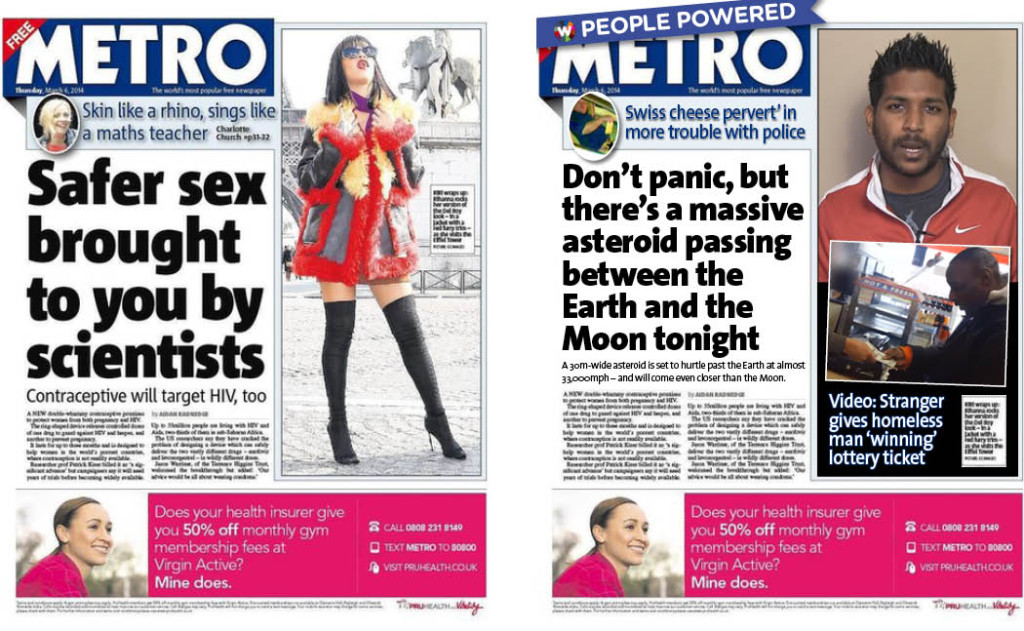What if front pages were selected by newspapers’ readers instead of their editors? At NewsWhip, we’re always interested in the news stories people are choosing to share – and how those stories differ from the normal news stories editors put on the front pages of big newspapers. So we ran a little experiment.
On Wednesday morning, we gathered the front pages of leading newspapers in several countries. Then we used Spike to check the most shared stories from each one.
A little work at our end, and we used those most shared stories to make new “people powered” front pages for each newspaper – giving the most shared story the most prominence, the second most shared the second most prominence, etc.
We replaced headlines and pictures, though did not get into replacing story text and bylines. The results are pretty neat – maybe even thought provoking.
For each paper we have the original front page on the left, and the “people powered” one on the right. Scroll through and take a look at the contrast.
The Wall Street Journal

Obama seeking funding for veterans is the lead story for the WSJ on social networks.
“Why This Plane Seat is the Most Profitable” is a most curious headline, and any story with rappers, dragons and fantasy deserves prominence. They beat out the editorially selected stories. As a WSJ subscriber while I lived in New York, I found the style, life, and culture writing in that paper second to none. Turns out the readers of the journal would put much of it right onto the front page.
The Washington Post

Here, a story about same-sex marriage displaces a story about wounded veterans, pushing it to second place prominence. The birth of four lion clubs gets star placement, along with a piece on Michelle Obama.
The New York Times

Most shared NY Times story? It’s about a viral post that drew attention to a Brooklyn school. Social media does love stories about social media.
The death of Sherland Nuland was shared by many, bumping it onto the Times front page.
A story about a bike path also made the cut, presumably driven by the sharing among the cycling constituency. An article on the Top 10 Ramen destinations in NY also makes the cut. Of course.
USA Today

“Teen who sued parents for college funds denied” firmly displaces the Ukraine crisis from the front page here.
A report on the softening of Clinton’s negative image holds second place on the front page – and on social media. Interestingly, when you ask USA Today readers on Facebook and Twitter, Budget news trumps Dancing with Stars!
The New York Post

The NY Post published the same event that drove big shares on social, though a different story (or at least headline).
Daily Mail

Who knew Daily Mail readers are health obsessed?
The Guardian

Who would predict that the Daily Mail and The Guardian would have the same lead story, if it were chosen by their readers?
The health story (which Guardian front page editor gave a number two spot to) was their social number one. Meanwhile, international affairs in the social version trump local NHS and lifestyle stories.
The Irish Times

Irish Times readers seem to care more about international Ukraine news than local EU debt terms – at least on social media. A story about collusion in extrajudicial killings also makes the “social” front page, displacing a personal injuries action for €5 million.
The Toronto Star

The Toronto Star’s readers might have had enough fun sharing Rob Ford stories. Instead, they’re getting excited about health benefits of red wine and unpaid interns. News about Chrysler and a new post box design also make the “social” cut.
Daily Mirror
Metro
The Independent
The Daily Telegraph
Methodology
We gathered our data using NewsWhip Spike’s publisher view, which breaks out stories by social shares, place of publication and other details.

(To see the paper-by-paper breakout of viral stories and to get more predictive data around trending stories, try out NewsWhip’s professional platform, Spike.)














